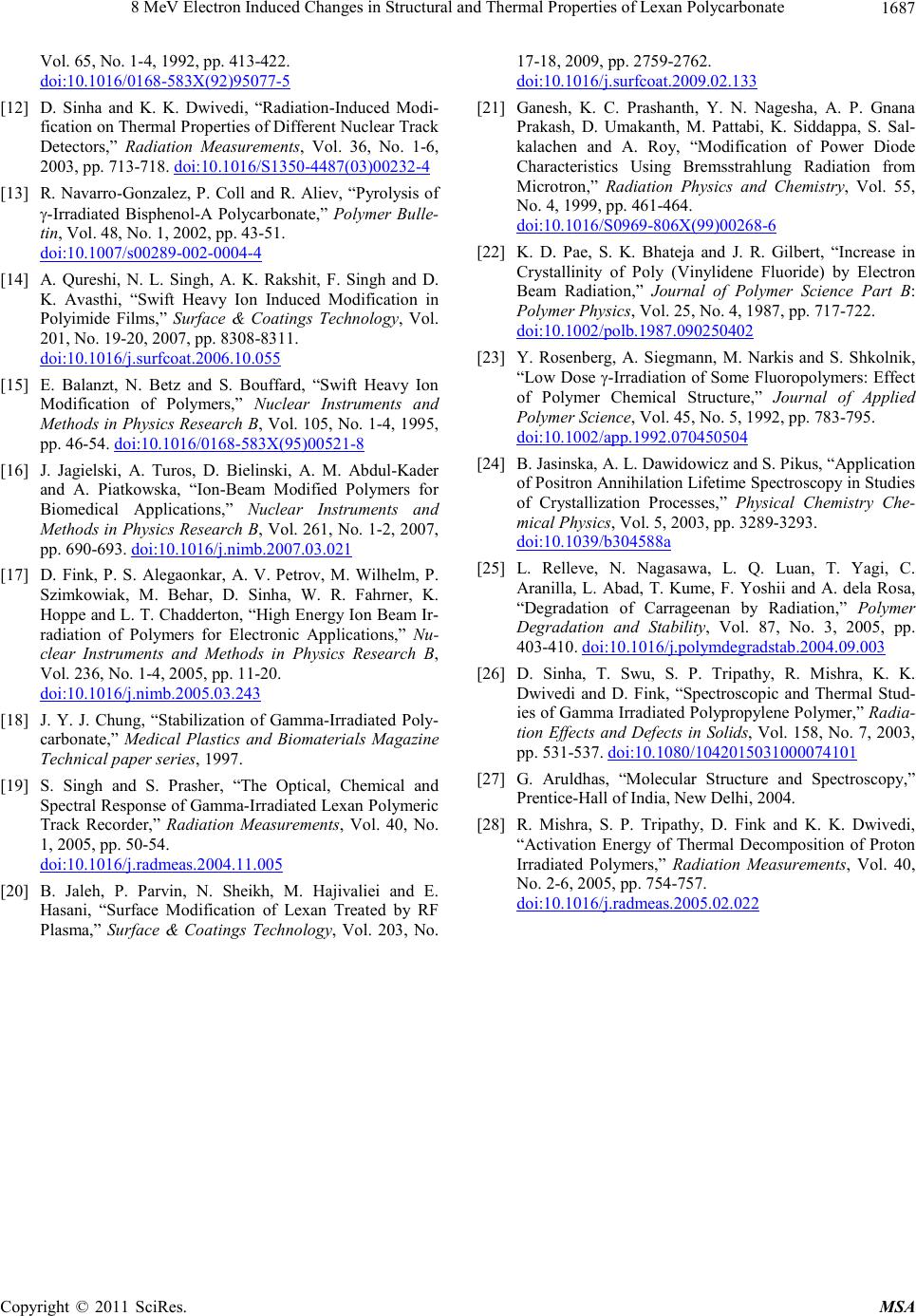
8 MeV Electron Induced Changes in Structural and Thermal Properties of Lexan Polycarbonate
Copyright © 2011 SciRes. MSA
1687
Vol. 65, No. 1-4, 1992, pp. 413-422.
doi:10.1016/0168-583X(92)95077-5
[12] D. Sinha and K. K. Dwivedi, “Radiation-Induced Modi-
fication on Thermal Properties of Different Nuclear Track
Detectors,” Radiation Measurements, Vol. 36, No. 1-6,
2003, pp. 713-718. doi:10.1016/S1350-4487(03)00232-4
[13] R. Navarro-Gonzalez, P. Coll and R. Aliev, “Pyrolysis of
-Irradiated Bisphenol-A Polycarbonate,” Polymer Bulle-
tin, Vol. 48, No. 1, 2002, pp. 43-51.
do i:1 0.10 07 /s00 28 9 -002 -00 04 -4
[14] A. Qureshi, N. L. Singh, A. K. Rakshit, F. Singh and D.
K. Avasthi, “Swift Heavy Ion Induced Modification in
Polyimide Films,” Surface & Coatings Technology, Vol.
201, No. 19-20, 2007, pp. 8308-8311.
doi:10.1016/j.surfcoat.2006.10.055
[15] E. Balanzt, N. Betz and S. Bouffard, “Swift Heavy Ion
Modification of Polymers,” Nuclear Instruments and
Methods in Physics Research B, Vol. 105, No. 1-4, 1995,
pp. 46-54. doi:1 0.10 16 /01 68 -58 3X (95 ) 0052 1 -8
[16] J. Jagielski, A. Turos, D. Bielinski, A. M. Abdul-Kader
and A. Piatkowska, “Ion-Beam Modified Polymers for
Biomedical Applications,” Nuclear Instruments and
Methods in Physics Research B, Vol. 261, No. 1-2, 2007,
pp. 690-693. doi:10.1016/j.nimb.2007.03.021
[17] D. Fink, P. S. Alegaonkar, A. V. Petrov, M. Wilhelm, P.
Szimkowiak, M. Behar, D. Sinha, W. R. Fahrner, K.
Hoppe and L. T. Chadderton, “High Energy Ion Beam Ir-
radiation of Polymers for Electronic Applications,” Nu-
clear Instruments and Methods in Physics Research B,
Vol. 236, No. 1-4, 2005, pp. 11-20.
doi:10.1016/j.nimb.2005.03.243
[18] J. Y. J. Chung, “Stabilization of Gamma-Irradiated Poly-
carbonate,” Medical Plastics and Biomaterials Magazine
Technical paper series, 1997.
[19] S. Singh and S. Prasher, “The Optical, Chemical and
Spectral Response of Gamma-Irradiated Lexan Polymeric
Track Recorder,” Radiation Measurements, Vol. 40, No.
1, 2005, pp. 50-54.
doi:10.1016/j.radmeas.2004.11.005
[20] B. Jaleh, P. Parvin, N. Sheikh, M. Hajivaliei and E.
Hasani, “Surface Modification of Lexan Treated by RF
Plasma,” Surface & Coatings Technology, Vol. 203, No.
17-18, 2009, pp. 2759-2762.
doi:10.1016/j.surfcoat.2009.02.133
[21] Ganesh, K. C. Prashanth, Y. N. Nagesha, A. P. Gnana
Prakash, D. Umakanth, M. Pattabi, K. Siddappa, S. Sal-
kalachen and A. Roy, “Modification of Power Diode
Characteristics Using Bremsstrahlung Radiation from
Microtron,” Radiation Physics and Chemistry, Vol. 55,
No. 4, 1999, pp. 461-464.
doi:10.1016/S0969-806X(99)00268-6
[22] K. D. Pae, S. K. Bhateja and J. R. Gilbert, “Increase in
Crystallinity of Poly (Vinylidene Fluoride) by Electron
Beam Radiation,” Journal of Polymer Science Part B:
Polymer Physics, Vol. 25, No. 4, 1987, pp. 717-722.
do i:1 0.10 02 /po lb. 19 87. 0902 50 402
[23] Y. Rosenberg, A. Siegmann, M. Narkis and S. Shkolnik,
“Low Dose -Irradiation of Some Fluoropolymers: Effect
of Polymer Chemical Structure,” Journal of Applied
Polymer Science, Vol. 45, No. 5, 1992, pp. 783-795.
do i:1 0.10 02 /ap p. 199 2. 07 0450 50 4
[24] B. Jasinska, A. L. Dawidowicz and S. Pikus, “Application
of Positron Annihilation Lifetime Spectroscopy in Studies
of Crystallization Processes,” Physical Chemistry Che-
mical Physics, Vol. 5, 2003, pp. 3289-3293.
doi:10.1039/b304588a
[25] L. Relleve, N. Nagasawa, L. Q. Luan, T. Yagi, C.
Aranilla, L. Abad, T. Kume, F. Yoshii and A. dela Rosa,
“Degradation of Carrageenan by Radiation,” Polymer
Degradation and Stability, Vol. 87, No. 3, 2005, pp.
403-410. doi:10.1016/j.polymdegradstab.2004.09.003
[26] D. Sinha, T. Swu, S. P. Tripathy, R. Mishra, K. K.
Dwivedi and D. Fink, “Spectroscopic and Thermal Stud-
ies of Gamma Irradiated Polypropylene Polymer,” Radia-
tion Effects and Defects in Solids, Vol. 158, No. 7, 2003,
pp. 531-537. doi:10.1080/1042015031000074101
[27] G. Aruldhas, “Molecular Structure and Spectroscopy,”
Prentice-Hall of India, New Delhi, 2004.
[28] R. Mishra, S. P. Tripathy, D. Fink and K. K. Dwivedi,
“Activation Energy of Thermal Decomposition of Proton
Irradiated Polymers,” Radiation Measurements, Vol. 40,
No. 2-6, 2005, pp. 754-757.
doi:10.1016/j.radmeas.2005.02.022